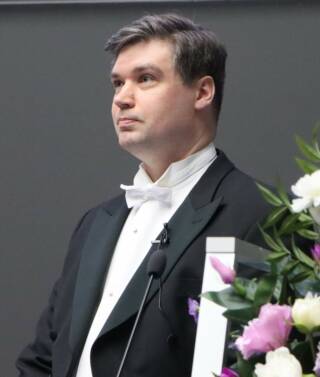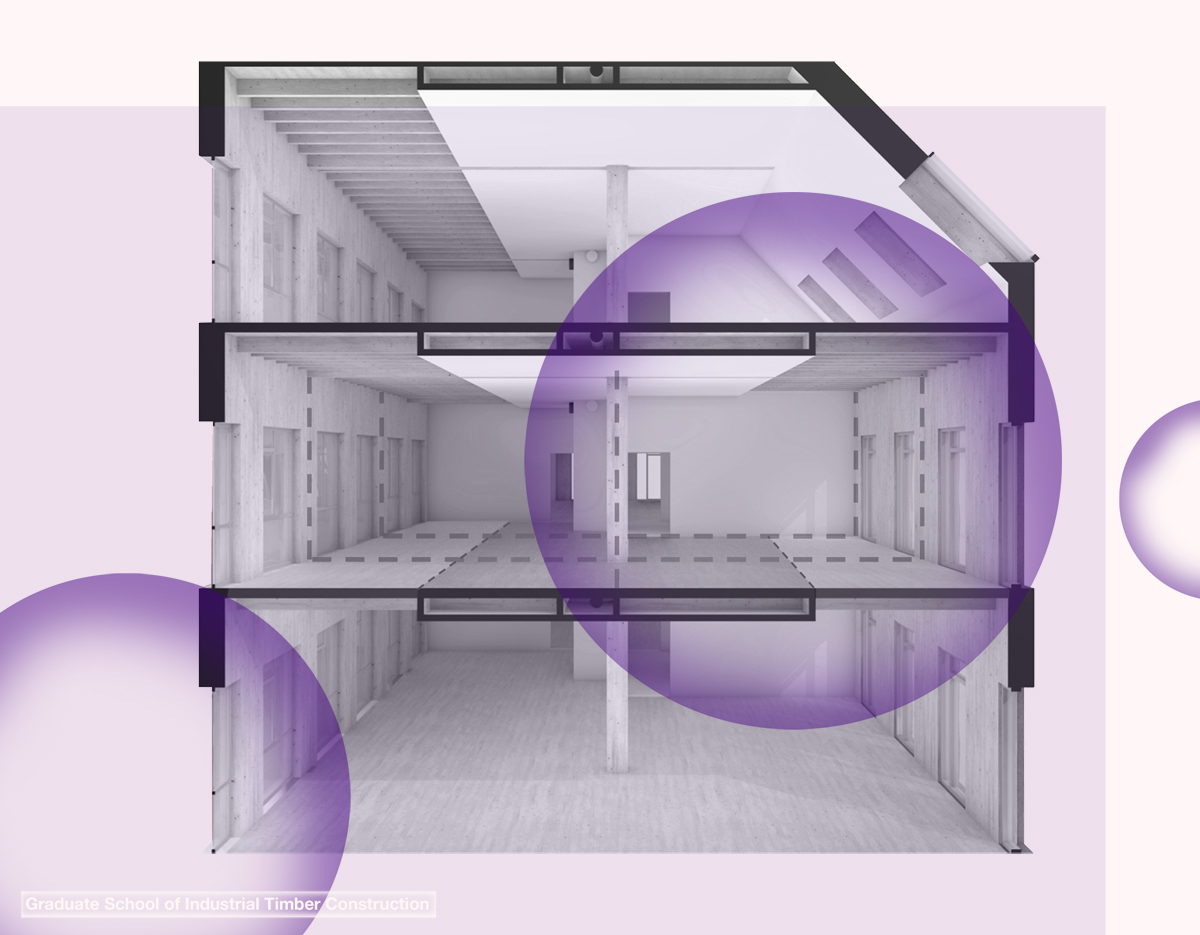The Graduate School of Industrial Timber Construction currently has total of eight Ph.D. projects running. Here you can preview our topics and the people behind the work.
How do our dissertation topics vary?

Published dissertations
Wood & Acoustics – 2024

Jesse Lietzén
Calculation of impact sound insulation of wooden intermediate floor structures. Jesse’s work in the development of acoustic computational models also gets excellent synergy from his second role as a project manager in the Department of Acoustical Engineering AINS Group (A-Insinöörit). Acoustics is a very important aspect in timber construction, so Jesse’s work is to enable competitiveness of wooden structures in this perspective.
Jesse’s dissertation can be found here.
Ongoing dissertations
Fire and Load Bearing Wood

Mika Alanen
Auto-extinction of load-bearing wooden structures and engineered mass timber products fire behaviour. In his work, Mika deals with one of the key aspects of wood construction, ie fire safety and fire design parameters. In addition to the graduate school, Mika works in our own fire laboratory and is responsible for fire testing and research there.
Real-estate Development

Juha Franssila
Value networks in real estate development in wooden apartment building construction. Juha has started his dissertation research at the faculty before, but he has also been integrated into the graduate school. The aim of Juha’s work is to produce new information about the management of wooden apartment building networks and value creation phenomena from the perspective of long-term cooperation.
Structural Design and Industrial Wood

Aku Aspila: Design principles for shallow steel-timber composite structures – Developing the Nordic system
Aku’s research explores the Nordic System, an innovative shallow steel-timber composite (STC) floor solution aimed at boosting structural performance and environmental sustainability in modern construction. Unlike traditional configurations, where steel beams support timber slabs from below, the Nordic System aligns these elements at the same level, maximizing room height and minimizing vertical material usage.
Aku addresses gaps in existing literature on shallow STC floors by developing analytical calculation models based on extensive empirical data, offering a comprehensive global perspective. The findings reveal that these models are highly accurate in predicting structural performance metrics such as loadbearing capacity and vibration. Additionally, the tests uncovered new structural characteristics, underscoring the need for innovative design frameworks to standardize shallow STC floors.
Overall, Aku’s work advances sustainable building practices by aligning with evolving Eurocode standards and promoting the industry-wide adoption of environmentally responsible construction solutions.
Industrial Wood and Architecture : Case Studies

Antti Tuure : Space Efficiency and Material Efficiency in Timber Apartment Buildings Based on Architectural and Structural Solutions Used in Case Studies
Antti’s research focuses on design principles related to space efficiency and material efficiency, which are linked to project feasibility, sustainability, and the circular economy.
His work involves numerous case studies of constructed timber apartment buildings, exploring the architectural and structural solutions employed. Special attention is given to net apartment efficiency, the thickness of structural elements, and comparative analyses of material efficiency and the carbon footprints of intermediate floors.
In addition to his academic work, Antti runs his own architectural firm.
Advantages of Wood in Housing Construction

Harri Sivu
Components of competitiveness in wooden housing construction. As wood construction has emerged as a viable option in apartment building construction, its competitiveness will be further weakened by certain traditional processes, calculation methods and contractual technical aspects that are not suitable for wood construction as such. Harri’s work addresses these areas and brings about solutions that enhance the competitiveness of wood construction. Harri wrestles with the same challenges in his everyday operations at his company called Harristo.
Multi-storey Timber Housing and Circular Economy

Ninni Westerholm
Multi-storey timber housing through the circular economy lens. Ninni evaluates modern wood construction methods from the circularity point of view and strives to provide a framework for how to design and construct more sustainable timber housing for urban environments. Her research goes further than only looking for more sustainable ways to build out of wood, she also maps how our system prevents, hinders or complicates sustainable development and how the system should change in order to boost circular timber construction. In addition to her research work, Ninni works as architect, sustainability consultant, and developer of LCA tools.
Industrial Bamboo and Architecture

Teemu Hirvilammi
Potential for Industrial Bamboo Housing: Reflecting Wood and Bamboo Structural Systems for Sustainable Housing in Urban Chinese Context. The impact of structural systems of residential mid-rise timber buildings on housing design and on the appearance in cityscape – and reflecting that potential to bamboo.
Teemu Hirvilammi is a University Instructor for architectural constructions in Tampere University and a Visiting Professor at Guangdong University of Technology. Teemu has also a long experience for entrepreneurship, and is a practicing architect via his own office, Hirvilammi Architects Ltd.
Structural engineering and the use of fungi

Shaghayegh Elahi: Development of Wood Construction Components Utilizing Advanced Lignocellulosic Materials
Shaghayegh’s research focuses on integrating innovative, sustainable mycelium bio composites into building materials to enhance structural performance. By adjusting the growth conditions and key parameters of manufacturing process, her work aims to maximize its mechanical properties for use in various construction applications. A significant part of the research involves investigating the mechanical behaviour of sandwich-structured bio-composites composed of cross-laminated timber (CLT) and mycelium laminates.
The main objective of the project is to explore the practical applications of mycelium-based composites in different building components, evaluating their exceptional potential in terms of mechanical performance, sustainability, and scalability for the construction industry. The research is part of the CIMANET doctoral education network, which is conducted in collaboration with Aalto University, contributing to advancements in sustainable materials development for structural use.
Shaghayegh brings a strong background in materials science, with special expertise in polymers and composites, providing a solid foundation for her work in pioneering eco-friendly construction materials.
Fire safe wood fiber-based thermal insulation in timber construction

Jami Järvinen
Jami’s research focuses on wood fiber-based thermal insulation used in timber construction. The aim of the research is to explore the potential of increasing the use of wood fiber-based thermal insulation in sustainable timber buildings that are more challenging in terms of fire safety. In addition, the growing demand for wood fiber insulation and the value creation in Finland arising from improving the degree of processed wood products will be investigated. As an essential part of the research, the environmental effects of switching to bio-based products in the thermal insulation market are explored.
In addition to his research work, Jami has worked with housing design.
Prediction of the airborne and impact sound insulation of wooden floor constructions

Lauri Talus
The aim of Lauri’s research is to examine different aspects of timber construction which have an effect on the sound insulation performance of wooden intermediate floors and to find accurate and efficient means of predicting said performance computationally. In addition to academic work, Lauri is employed as an acoustic engineer at AINS Group (A-Insinöörit), where he works with building acoustics and computational acoustics.

















